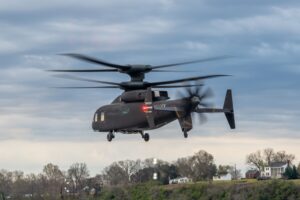Sikorsky [LMT] and Boeing [BA] have completed a long-haul flight with their technology demonstrator for the Army’s Future Long Range Assault Aircraft (FLRAA) program, flying the helicopter 700 nautical miles from West Palm Beach, Florida to Nashville, Tennessee.
The two companies detailed the endurance accomplishment on Thursday ahead of next week’s Army Aviation Association of America annual conference in Nashville, where the SB>1 Defiant platform, which has informed their Defiant X coaxial rigid rotor helicopter offering for FLRAA, will be on display.

“This monumental flight further proves the maturity of the Defiant design and that it is ready to support the Army’s future long-range assault missions,” Mark Cherry, Boeing’s vice president and general manager for vertical lift, said in a statement. “Just as SB>1 DEFIANT flew safely over multiple states from Florida to Tennessee, DEFIANT X will safely fly and meet all of our customer’s objectives.”
Paul Lemmo, president of Sikorsky, told reporters the SB>1 Defiant flew at an average speed of 175 to 180 knots while using 50 percent of the engine power during the one-day, 7-hour flight on March 21, which required two fuel stops along the way.
The Sikorsky-Boeing team offering Defiant X and Bell [TXT], offering its V-280 Valor tiltrotor aircraft, are the two competitors for the Army’s FLRAA program to find a replacement for its UH-60Black Hawk helicopters.
The two teams, which both participated in the Joint Multi-Role Technology Demonstrator program to inform FLRAA requirements, have submitted their proposals for the program of record with the Army set to select a winner for production this summer.
Sikorsky and Boeing on Thursday also announced six additional suppliers that have joined their Defiant X team for FLRAA.
“Team Defiant is building a strong nationwide supply chain to provide the Army a transformational aircraft,” Paul Lemmo, president of Sikorsky, said in a statement. “This team and its proven experience will ensure that Defiant X is a low-risk, reliable and survivable aircraft for our Soldiers and the Army’s long-range assault mission.”
The vendors include ATI Forged Products for gearbox forgings, Collins Aerospace [RTX] with its Perigon flight control system and vehicle management computer as well as the aircraft’s seats, Elbit Systems of America for the mission system computer, Parker Aerospace for flight controls and hydraulic pumps and modules, Magnaghi Aeronautica for the landing gear and Marotta Controls for electrical power system components.
“Perigon’s enhanced processing power will allow it to integrate numerous functions, including flight control, utility management, prognostic health and advanced flight modes such as autonomy,” said Kim Kinsley, Collins Aerospace’s vice president and general manager of environmental and airframe control systems, said in a statement. “By using a single computer to support a multitude of functions, Perigon will help reduce the number of computers onboard the aircraft thus reducing weight, volume and power consumption across the platform while enabling enhanced performance.”
In February, Sikorsky and Boeing also announced they selected Honeywell’s [HON] new HTS7500 turboshaft engine to power Defiant X (Defense Daily, Feb. 10).
Last year, Sikorsky and Boeing detailed their Defiant X offering, which they said builds on the experience flying SB>1 Defiant for several years and includes enhancements to the design “to reduce thermal signature and improve aerodynamic handling” and “fly-by-wire flight controls integrated with autonomy capability” (Defense Daily, Jan. 25 2021).
Bell announced last June it was retiring its V-280 technology demonstrator from active flight testing, after reaching 214 flight hours and a max speed of 305 knots, as it readies for the FLRAA program of record (Defense Daily, June 24).
Lemmo told reporters Sikorsky and Boeing plan to continue flying SB>1 Defiant, while declining to offer specifics on planned flight activities.
“This aircraft has a lot of life left, so we’re going to continue to fly it as long as we can and get that risk reduction so on day one of the award we’re ready to go. And if we can, we’ll continue to fly it even past day one of the award. As long as we feel we can get some risk reduction through flight testing, we will do it,” Lemmo said.